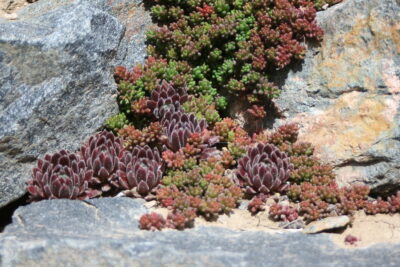
Guide: How to Successfully Propagate an Ogre Ear Succulent

Propagating succulents has become a popular hobby for many plant enthusiasts. One type of succulent that has gained attention is the Ogre Ear succulent. Known for its unique appearance and low maintenance requirements, the Ogre Ear succulent is a great addition to any garden or indoor plant collection. However, successfully propagating this particular succulent can be a bit tricky without the right knowledge and techniques.
We will provide a comprehensive guide on how to successfully propagate an Ogre Ear succulent. We will start by explaining what propagation is and why it is beneficial for succulent plants. Then, we will delve into the specific steps and methods you need to follow in order to propagate an Ogre Ear succulent successfully. We will cover everything from selecting the right parent plant to preparing the propagation materials and caring for the newly propagated succulents. By the end of this article, you will have all the information you need to confidently propagate your own Ogre Ear succulent and expand your succulent collection.
- Choose a healthy and mature ogre ear succulent for propagation
- Use a clean and sharp knife or pruning shears to take a cutting from the parent plant
- Allow the cutting to callous over for a few days to prevent rotting
- Prepare a well-draining potting mix with a combination of perlite, sand, and potting soil
- Plant the cutting in the potting mix, making sure it is firmly rooted
- Place the potted cutting in a warm and bright location, but away from direct sunlight
- Water the cutting sparingly, allowing the soil to dry out between waterings
- Mist the cutting occasionally to provide humidity for root development
- Be patient and wait for roots to develop, which may take several weeks
- Once roots have formed, gradually acclimate the new plant to more sunlight
- After a few months, you can transplant the new ogre ear succulent into a larger pot if desired
- Continue to provide a balanced and regular watering and fertilizing routine to support the plant's growth
- Frequently Asked Questions
Choose a healthy and mature ogre ear succulent for propagation
When it comes to propagating an ogre ear succulent, it is essential to start with a healthy and mature plant. Look for a plant that is free from any signs of disease or damage. The leaves should be plump and firm, without any discoloration or spots.
Additionally, choose a plant that has reached maturity. A mature ogre ear succulent will have a well-established root system, which will increase the chances of successful propagation.
Prepare the necessary materials
Before you begin the propagation process, gather all the necessary materials. This will ensure a smooth and efficient propagation experience.
- Sharp, sterilized scissors or pruning shears
- A clean, well-draining pot or container
- A suitable potting mix for succulents
- A spray bottle filled with water
- Rooting hormone (optional)
Having these materials ready will save you time and make the propagation process much easier.
 Alternative Methods of Propagating Succulents: Beyond Seeds
Alternative Methods of Propagating Succulents: Beyond SeedsChoose the appropriate propagation method
There are several methods you can use to propagate an ogre ear succulent:
- Leaf propagation: This method involves removing a healthy leaf from the parent plant and allowing it to sprout roots and form a new plant.
- Stem cutting propagation: With this method, you will take a stem cutting from the parent plant and encourage it to develop roots and grow into a new plant.
- Offsets or pups propagation: If your ogre ear succulent has produced offsets or pups, you can separate them from the parent plant and plant them individually to propagate new plants.
Choose the propagation method that suits your preferences and the resources you have available.
Follow the propagation steps
Once you have chosen your preferred propagation method, it is time to follow the necessary steps to successfully propagate your ogre ear succulent.
Leaf propagation:
- Select a healthy leaf from the parent plant, ensuring that it is fully intact and free from any damage.
- Allow the leaf to dry and callous for a few days.
- Place the dried leaf on top of a well-draining potting mix, ensuring that the end with the stem is facing downwards.
- Mist the leaf with water occasionally to keep it slightly moist.
- After a few weeks, roots should start to develop, followed by new growth. Once the new plant has established roots and several leaves, you can transplant it into its own pot.
Stem cutting propagation:
- Take a clean and sharp pair of scissors or pruning shears and cut a stem from the parent plant, ensuring that it is at least a few inches long.
- Allow the cut end of the stem to dry and callous for a few days.
- Insert the dried end of the stem into a pot filled with well-draining potting mix.
- Mist the soil lightly and place the pot in a warm and bright location, avoiding direct sunlight.
- Over time, roots will develop from the cut end of the stem, and new growth will emerge. Once the new plant has established roots and several leaves, you can transfer it to a larger pot.
Offsets or pups propagation:
- Gently separate the offsets or pups from the parent plant, ensuring that each has its own set of roots.
- Plant the offsets or pups in small individual pots filled with well-draining potting mix.
- Water the newly planted offsets or pups lightly and place them in a warm and bright location.
- As the plants grow, you can gradually increase the amount of water and provide them with proper care.
Remember to be patient during the propagation process, as it can take some time for the new plants to establish themselves. With proper care and attention, you will soon have new ogre ear succulents to enjoy!
 Can Succulent Plants Reproduce and Become Pregnant?
Can Succulent Plants Reproduce and Become Pregnant?Use a clean and sharp knife or pruning shears to take a cutting from the parent plant
To successfully propagate an Ogre Ear Succulent, the first step is to use a clean and sharp knife or pruning shears to take a cutting from the parent plant. This cutting will serve as the starting point for your new succulent.
Allow the cutting to callous over for a few days to prevent rotting
When propagating an Ogre Ear succulent, it is crucial to allow the cutting to callous over before planting it. This step is essential to prevent rotting and ensure successful propagation.
After taking a cutting from the mother plant, set it aside in a dry and well-ventilated area for a few days. During this time, the cut end of the stem will form a dry, protective layer known as a callus. This callus acts as a barrier against infection and moisture, reducing the risk of rotting.
To promote callus formation, place the cutting in a warm and bright location, away from direct sunlight. Avoid exposing it to excessive moisture, as this can hinder callus formation and increase the chances of rotting.
Quick Tip: You can speed up callus formation by applying a rooting hormone to the cut end of the stem before allowing it to callous over.
Prepare a well-draining potting mix with a combination of perlite, sand, and potting soil
When it comes to propagating an Ogre Ear Succulent, it is crucial to provide the right growing conditions for the new plant to thrive. One of the most important steps is to prepare a well-draining potting mix. This ensures that excess water doesn't accumulate around the roots, which can lead to rotting.
 Succulent Propagation: A Guide to Time Required
Succulent Propagation: A Guide to Time RequiredTo create the perfect potting mix for your Ogre Ear Succulent, you will need a combination of perlite, sand, and potting soil. Perlite is a lightweight and porous material that improves drainage, while sand adds extra grit to prevent waterlogging. Potting soil provides the necessary nutrients and organic matter for the succulent to grow.
Here's how to prepare the well-draining potting mix:
- Start by filling a large container or bucket with potting soil.
- Add perlite to the potting soil and mix well. Aim for a ratio of approximately 1 part perlite to 3 parts potting soil.
- Next, incorporate sand into the mix. Use a ratio of 1 part sand to 3 parts potting soil. Thoroughly blend all the components together.
Once you have prepared the well-draining potting mix, you are ready to move on to the next step in the propagation process.
Plant the cutting in the potting mix, making sure it is firmly rooted
When propagating an Ogre Ear succulent, it is crucial to properly plant the cutting in the potting mix. This step ensures that the cutting has a stable and secure foundation to grow from.
Start by selecting a well-draining potting mix that is specifically formulated for succulents. This type of soil will prevent the cutting from sitting in excess moisture, which can lead to root rot.
Next, create a small hole in the potting mix using your finger or a pencil. The hole should be deep enough to accommodate the entire cutting and allow for root growth.
 Indoor Gardening: Growing Spider Web Succulents at Home
Indoor Gardening: Growing Spider Web Succulents at HomePro tip: You can also dip the cut end of the succulent cutting in a rooting hormone powder before planting it. This can enhance root development and increase the chances of successful propagation.
Once you have prepared the potting mix and created a hole, carefully place the cutting into the hole. Make sure that the cut end is inserted into the soil, while the remaining part of the cutting is above the surface.
Caution: Avoid burying the entire cutting in the soil, as this can lead to excessive moisture retention and hinder root development.
After placing the cutting in the potting mix, gently press the soil around it to ensure it is firmly rooted. This will provide stability and support for the cutting as it begins to grow.
Place the potted cutting in a warm and bright location, but away from direct sunlight
When propagating an Ogre Ear Succulent, one of the most crucial steps is to find the perfect location for your potted cutting. This will ensure that it receives the ideal amount of warmth and light to encourage healthy growth.
While succulents thrive in bright conditions, it's important to keep them away from direct sunlight, especially during the initial stages of propagation. Direct sunlight can be too intense and may cause the cutting to wilt or burn.
Instead, choose a warm and bright location for your potted cutting. A window sill or a spot near a south-facing window is often a great choice. The succulent will benefit from the natural light, but the window glass will help filter out the harsh direct sunlight.
 Exploring Root Depths in Succulents: Understanding Root Growth
Exploring Root Depths in Succulents: Understanding Root GrowthIt's also important to consider the temperature of the location. Ogre Ear Succulents prefer temperatures between 65°F and 75°F (18°C and 24°C). Avoid placing the cutting in areas with extreme temperature fluctuations or near drafts, as this can negatively impact its growth.
Water the cutting sparingly, allowing the soil to dry out between waterings
When it comes to propagating an Ogre Ear Succulent, one of the most crucial steps is proper watering of the cutting. It is essential to water the cutting sparingly, allowing the soil to dry out between waterings.
Overwatering can lead to root rot and other issues, so it's important to strike the right balance. The best approach is to wait until the soil is completely dry before giving the cutting a small amount of water.
When watering, make sure to direct the water towards the base of the cutting, avoiding the leaves and stem as much as possible. This helps prevent any excess moisture from lingering on the plant, which can lead to fungal diseases.
Tips for successful watering:
- Use well-draining soil to prevent water from pooling around the roots.
- Check the moisture level of the soil by inserting your finger about an inch deep. If it feels dry, it's time to water.
- Avoid using a spray bottle to water the cutting, as it may not provide sufficient water to reach the roots.
- During winter or dormancy periods, reduce watering frequency to prevent overhydration.
By following these watering guidelines, you can ensure that your Ogre Ear Succulent cutting receives the right amount of moisture for successful propagation.
 Vertical Succulents: Discover Which Types Grow Straight Up
Vertical Succulents: Discover Which Types Grow Straight UpMist the cutting occasionally to provide humidity for root development
When propagating an Ogre Ear Succulent, it is important to provide the right conditions for root development. One way to do this is by misting the cutting occasionally to create a humid environment. This will help the cutting retain moisture and encourage the growth of new roots.
Be patient and wait for roots to develop, which may take several weeks
When propagating an Ogre Ear Succulent, it is important to be patient and allow enough time for roots to develop. This process can take several weeks, so it's crucial to resist the temptation to rush the process.
Once roots have formed, gradually acclimate the new plant to more sunlight
Once your ogre ear succulent has successfully developed roots, it is important to gradually introduce it to more sunlight. This process is crucial to ensure the plant's health and prevent any potential damage from sudden exposure to intense sunlight.
Here are some steps to follow when acclimating your new ogre ear succulent to more sunlight:
 Can Succulents Easily Spread and Overrun Gardens?
Can Succulents Easily Spread and Overrun Gardens?- Start with indirect sunlight: Place the succulent in an area where it will receive bright, but indirect sunlight. This could be near a window with a sheer curtain or in a shaded outdoor spot.
- Monitor the plant's response: Keep a close eye on your succulent to observe how it reacts to the increased light. Look for any signs of stress, such as wilting or discoloration of the leaves. If you notice any negative effects, you may need to adjust the amount of sunlight it receives.
- Gradually increase exposure: After a few days of acclimating to indirect sunlight, you can start exposing the succulent to short periods of direct sunlight. Place it in a location where it receives a couple of hours of direct sunlight each day.
- Extend the exposure time: As the succulent adapts and shows no signs of stress, gradually increase the duration of direct sunlight exposure. Aim for around 4-6 hours of direct sunlight daily.
- Protect from intense midday sun: While ogre ear succulents can tolerate more sunlight than other succulent varieties, it's still important to protect them from intense midday sun. Consider providing some shade during the hottest parts of the day to prevent sunburn or leaf damage.
- Continue monitoring: Throughout the acclimation process, keep a close eye on your succulent's overall health. If you notice any negative changes or signs of stress, adjust the sunlight exposure accordingly. Every plant may have unique needs, so it's important to pay attention to its individual response.
By following these steps and gradually increasing the sunlight exposure, you can successfully acclimate your ogre ear succulent to thrive in its new environment. Remember, patience and careful observation are key when it comes to ensuring the well-being of your plants.
After a few months, you can transplant the new ogre ear succulent into a larger pot if desired
Transplanting your ogre ear succulent into a larger pot is an important step in its propagation journey. Giving the succulent more space will allow it to grow and thrive. Here's a step-by-step guide on how to successfully transplant your ogre ear succulent:
- Choose the right pot: Select a pot that is slightly larger than the current one, allowing room for the succulent's roots to spread. Make sure the new pot has drainage holes to prevent waterlogging.
- Prepare the pot: Fill the bottom of the new pot with a layer of well-draining soil. You can use a cactus or succulent-specific soil mix or create your own by combining regular potting soil with perlite or sand.
- Remove the succulent: Carefully remove the ogre ear succulent from its current pot. Gently loosen the soil around the roots and try not to damage them.
- Inspect the roots: Take a look at the roots of the succulent. If you notice any rotten or damaged roots, trim them with clean gardening shears.
- Place the succulent: Position the ogre ear succulent in the center of the new pot, ensuring that it is upright and at the same depth as it was in the previous pot.
- Fill the pot: Carefully fill the remaining space in the pot with the well-draining soil mix, pressing it gently around the roots. Avoid burying the succulent's stem too deep.
- Water the succulent: After transplanting, give the succulent a thorough watering, allowing excess water to drain out through the holes in the pot. This will help settle the soil and establish the succulent in its new home.
- Find the right spot: Place the newly transplanted ogre ear succulent in a location that receives bright, indirect sunlight. Avoid placing it in direct sunlight, as this can scorch the leaves.
- Maintain proper care: Continue to care for your ogre ear succulent by providing it with the right amount of water, ensuring the soil is well-draining, and periodically fertilizing it with a balanced succulent fertilizer.
Following these steps will ensure a successful transplant and give your ogre ear succulent a fresh start in its new pot. Remember to monitor the plant's growth and make any necessary adjustments to its care routine as it continues to thrive.
Continue to provide a balanced and regular watering and fertilizing routine to support the plant's growth
When it comes to propagating an Ogre Ear succulent, it's important to continue providing a balanced and regular watering and fertilizing routine. This will not only support the plant's growth but also ensure its overall health and vitality.
Watering is a crucial aspect of succulent care, and it becomes even more important during the propagation process. Once you have taken a healthy leaf or stem cutting from the parent plant, allow it to callous over for a few days. Afterward, place the cutting in well-draining soil and water it lightly. Avoid overwatering, as succulents are prone to root rot.
 Step-by-Step Guide to Propagating Bear Paw Succulent from a Leaf
Step-by-Step Guide to Propagating Bear Paw Succulent from a LeafAs the propagated cutting begins to develop roots and establish itself, it's essential to maintain a consistent watering schedule. Succulents like the Ogre Ear prefer infrequent and deep watering rather than frequent shallow watering. Wait until the soil is completely dry before watering again, and be sure to provide adequate drainage to prevent waterlogged conditions.
In addition to watering, fertilizing is another key aspect of supporting the growth of your propagated Ogre Ear succulent. Use a balanced and diluted fertilizer specifically formulated for succulents. It's recommended to fertilize the plant during the growing season, which is typically spring and summer.
Remember to follow the instructions provided on the fertilizer packaging and avoid over-fertilizing, as this can lead to nutrient burn and damage the succulent. A general rule of thumb is to fertilize the plant every 2-4 weeks, but adjust the frequency based on the specific fertilizer and the needs of your succulent.
By providing a balanced and regular watering and fertilizing routine, you are giving your propagated Ogre Ear succulent the best chance to thrive and grow into a beautiful and healthy plant.
Frequently Asked Questions
1. How often should I water my Ogre Ear Succulent?
Water your Ogre Ear Succulent when the top inch of soil is dry. Overwatering can cause root rot, so it's important to let the soil dry out between waterings.
2. Can I propagate an Ogre Ear Succulent from a leaf cutting?
 Propagating Succulent Leaves: A Guide to Growing New Plants
Propagating Succulent Leaves: A Guide to Growing New PlantsNo, Ogre Ear Succulents cannot be propagated from leaf cuttings. They can only be propagated through stem cuttings or by dividing offsets from the main plant.
3. How much sunlight does an Ogre Ear Succulent need?
Ogre Ear Succulents thrive in bright indirect sunlight. Place them near a window where they can receive 4-6 hours of sunlight per day, but avoid direct sunlight as it can scorch the leaves.
4. How often should I fertilize my Ogre Ear Succulent?
Fertilize your Ogre Ear Succulent once a month during the growing season (spring and summer) with a balanced succulent fertilizer. Dilute the fertilizer to half the recommended strength and apply it to damp soil.
If you want to read more articles similar to Guide: How to Successfully Propagate an Ogre Ear Succulent, you can visit the Propagation category.






You Must Read